Essay Contest Result
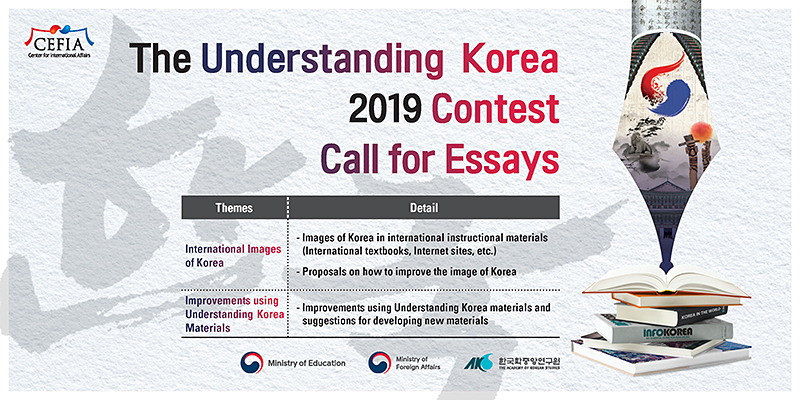
Teaching Resources about Korea and Proposal for “Maps of Korean Festivals”
I am a Korean language and culture teacher in Europe. I taught at the Korean Cultural Center’s King Sejong Institute in Hungary and am currently in my third year teaching at the King Sejong Institute at the University of Lisbon in Portugal. I would like to share my experiences using material about Korea in my classes and make a suggestion for the development of materials that can be used when teaching Korean.
Because research on Korea is less abundant in Europe compared to Asia, it is difficult to find material in the countries’ native languages. Because finding material on Korea in Hungarian or Portuguese is particularly challenging, I have used materials in my classes that are in English or translated by native speakers. However, I always want to use material in the native language because these two methods require a lot of preparation time and effort. After a lot of searching, I found “Korea in the World (2015)” (Figure 1). This is a book with general information about Korean history, economy, and culture and has been translated into 23 different languages. It has been used as supplementary material for medium-level students or higher. Many medium-level students inquire about references that contain objective information about Korea because most of them major in Korean studies. Whenever students inquire about this, I always recommend “Korea in the World.”
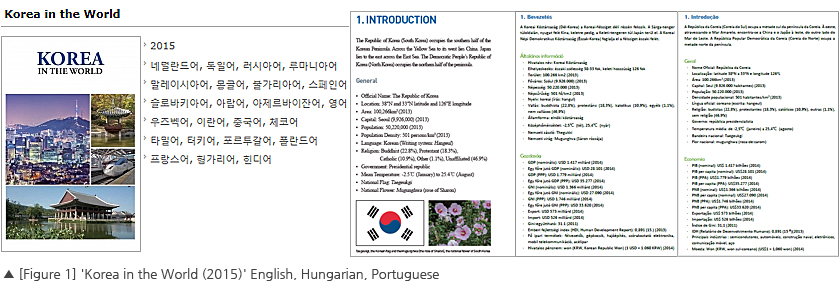
I have also used the “Understanding Korea Series” (Figure 2) as supplementary material in my courses after editing it slightly. Because this series includes detailed explanations on topics such as homes, religion, and education, I have recommended it to students who express interest in related topics during class.
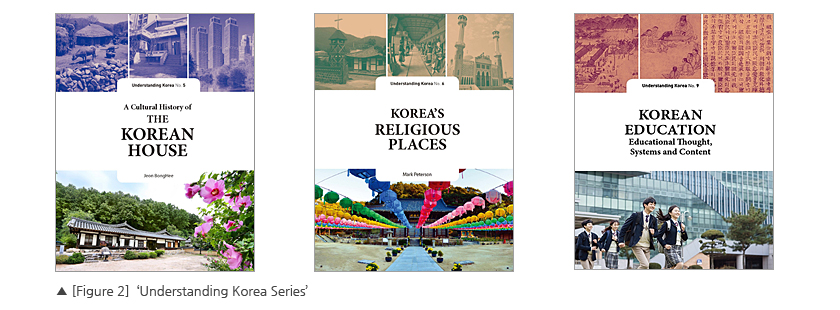
A third resource I have used often is “Exploring Korean History through World Heritage” (Figure 3). This resource introduces UNESCO-designated World Heritage Sites (Cultural, Recorded, and Intangible Heritages) found in Korea, and I use it when teaching “Travel” to beginning-level students. The appendix “World Heritage Map” has helped inspire students. Each topic in the book includes a QR code which students can use to obtain more information on their smartphones.
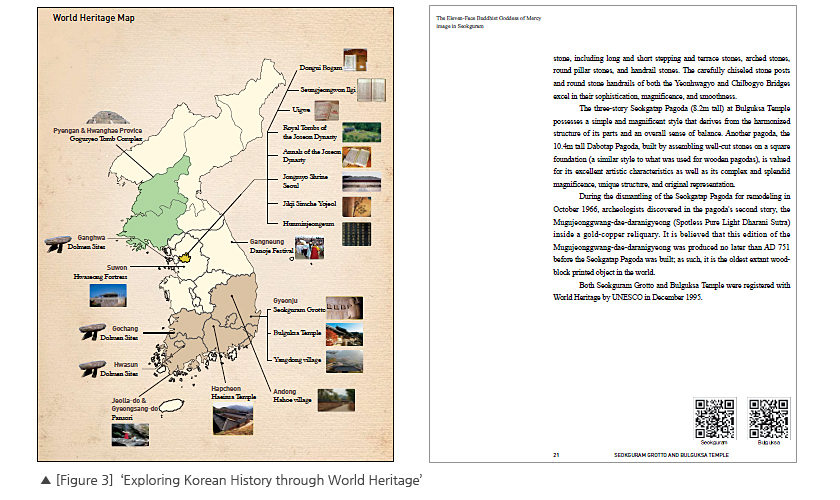
However, there is a downside when using these materials. They can be rather difficult to my students because they are non-Korean learners of Korean language instead of Korean studies researchers. Therefore, I have had to edit the materials before using them as supplemental resources. I would like to propose a resource that can be made to help non-Korean students easily understand Korea – “Maps of Korean Festivals.” Unlike Korea, Europe does not have many entertainment areas like karaoke rooms or PC cafes. Instead, each region and season has their own festival for entertainment. Each region of Portugal also has many festivals. The “Braga Romana” in Braga reenacts the Roman period, and the “Tabuleiros” festival in Tomar is celebrated every four years with parades of people with trays of religious flowers and bread. Throughout all of Europe, festivals attract people to new regions and act as an easy way to become acquainted with unfamiliar cultures. Therefore, I would like to propose using festivals to create a resource for understanding Korea called “Maps of Korean Festivals.”
First is the map of “Korea’s Top 10 Festivals. Ten representative Korean festivals that non-Koreans love can be found in the map in Figure 4. Each festival is represented by an image on the map. For example, the Boryeong Mud Festival (which is attended by many non-Koreans) is represented by an icon featuring a mud face mask located near Boryeong on the map of Korea. In this way, the representative festival of each region can be seen easily at a glance. This one resource can be used to teach many different topics in courses, such as travel, culture, and geography.
Second is maps of “Festivals by Topic.” As can be seen in Figure 5, this map shows regional festivals according to topics that non-Koreans have interest in, such as Korean food, history, historical sites, or regional specialty products. A good example is the “World Heritage Map” which shows historical sites. This type of map can be a great resource for activities when teaching a particular topic. By including QR codes on the maps, students will be able to find more information about each festival’s history, characteristics, and main events. For example, instructors can use a map about food festivals to teach about why particular foods are popular in certain regions. Historical festival maps can be linked to online information that explains the historical background with detailed information about the festivals.
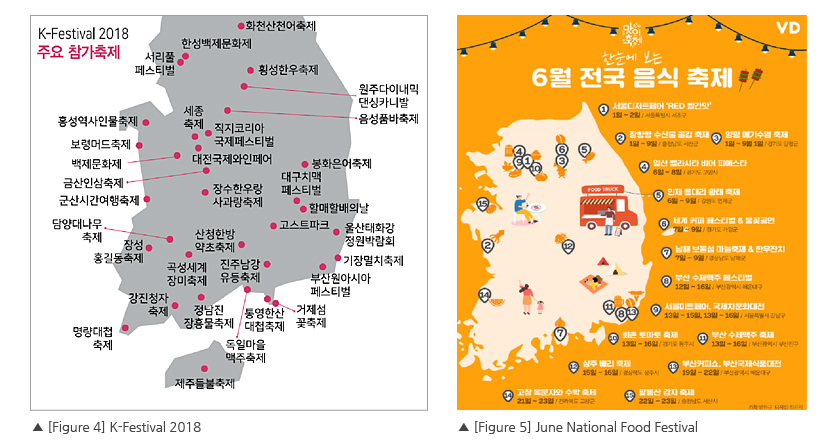
Third is making a YouTube channel about the maps of Korean Festivals. Recently, the amount of YouTube viewers has risen exponentially. For this project, a YouTube channel can be made to upload promotional videos for each festival. In addition, we can hold video competitions for people who attend festivals after using the “Maps of Korean Festivals.” The videos submitted during these competitions can be uploaded to the YouTube channel. These videos will become a valuable resource for bringing the spirit of the festivals to Korean language learners outside of Korea.
“Maps of Korean Festivals” will be an extremely useful resource in teaching Korean language abroad. They will be an easy and enjoyable way to teach about Korea’s geography, history, culture, and regional characteristics. They will go beyond simple teaching resources and act as a method of experiential learning.
Because research on Korea is less abundant in Europe compared to Asia, it is difficult to find material in the countries’ native languages. Because finding material on Korea in Hungarian or Portuguese is particularly challenging, I have used materials in my classes that are in English or translated by native speakers. However, I always want to use material in the native language because these two methods require a lot of preparation time and effort. After a lot of searching, I found “Korea in the World (2015)” (Figure 1). This is a book with general information about Korean history, economy, and culture and has been translated into 23 different languages. It has been used as supplementary material for medium-level students or higher. Many medium-level students inquire about references that contain objective information about Korea because most of them major in Korean studies. Whenever students inquire about this, I always recommend “Korea in the World.”

I have also used the “Understanding Korea Series” (Figure 2) as supplementary material in my courses after editing it slightly. Because this series includes detailed explanations on topics such as homes, religion, and education, I have recommended it to students who express interest in related topics during class.

A third resource I have used often is “Exploring Korean History through World Heritage” (Figure 3). This resource introduces UNESCO-designated World Heritage Sites (Cultural, Recorded, and Intangible Heritages) found in Korea, and I use it when teaching “Travel” to beginning-level students. The appendix “World Heritage Map” has helped inspire students. Each topic in the book includes a QR code which students can use to obtain more information on their smartphones.

However, there is a downside when using these materials. They can be rather difficult to my students because they are non-Korean learners of Korean language instead of Korean studies researchers. Therefore, I have had to edit the materials before using them as supplemental resources. I would like to propose a resource that can be made to help non-Korean students easily understand Korea – “Maps of Korean Festivals.” Unlike Korea, Europe does not have many entertainment areas like karaoke rooms or PC cafes. Instead, each region and season has their own festival for entertainment. Each region of Portugal also has many festivals. The “Braga Romana” in Braga reenacts the Roman period, and the “Tabuleiros” festival in Tomar is celebrated every four years with parades of people with trays of religious flowers and bread. Throughout all of Europe, festivals attract people to new regions and act as an easy way to become acquainted with unfamiliar cultures. Therefore, I would like to propose using festivals to create a resource for understanding Korea called “Maps of Korean Festivals.”
First is the map of “Korea’s Top 10 Festivals. Ten representative Korean festivals that non-Koreans love can be found in the map in Figure 4. Each festival is represented by an image on the map. For example, the Boryeong Mud Festival (which is attended by many non-Koreans) is represented by an icon featuring a mud face mask located near Boryeong on the map of Korea. In this way, the representative festival of each region can be seen easily at a glance. This one resource can be used to teach many different topics in courses, such as travel, culture, and geography.
Second is maps of “Festivals by Topic.” As can be seen in Figure 5, this map shows regional festivals according to topics that non-Koreans have interest in, such as Korean food, history, historical sites, or regional specialty products. A good example is the “World Heritage Map” which shows historical sites. This type of map can be a great resource for activities when teaching a particular topic. By including QR codes on the maps, students will be able to find more information about each festival’s history, characteristics, and main events. For example, instructors can use a map about food festivals to teach about why particular foods are popular in certain regions. Historical festival maps can be linked to online information that explains the historical background with detailed information about the festivals.

Third is making a YouTube channel about the maps of Korean Festivals. Recently, the amount of YouTube viewers has risen exponentially. For this project, a YouTube channel can be made to upload promotional videos for each festival. In addition, we can hold video competitions for people who attend festivals after using the “Maps of Korean Festivals.” The videos submitted during these competitions can be uploaded to the YouTube channel. These videos will become a valuable resource for bringing the spirit of the festivals to Korean language learners outside of Korea.
“Maps of Korean Festivals” will be an extremely useful resource in teaching Korean language abroad. They will be an easy and enjoyable way to teach about Korea’s geography, history, culture, and regional characteristics. They will go beyond simple teaching resources and act as a method of experiential learning.

